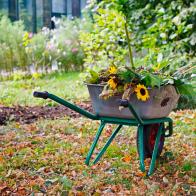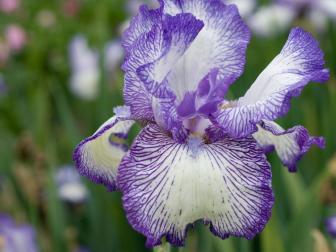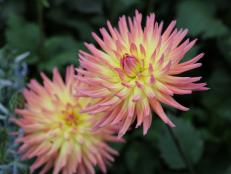Transplanting Irises
Learn how to dig and move bearded and Siberian irises.

Photo By: Michele Lewellyn
Grow iris, and at some point you’ll need to tackle transplanting iris. It doesn’t matter whether you’re growing bearded iris (Iris germanica) or Siberian iris (Iris sibirica), as plants grow and mature, a day will likely come when clumps become crowded, start to die out or flower numbers dwindle. Those are signals that it’s time to master transplanting iris.
When to Transplant Iris
The most important aspect of transplanting iris is timing. For bearded iris, the ideal time for digging and dividing is in late summer to early fall. Bearded iris are less susceptible to bacterial and fungal rots at this time because weather tends to be drier. The general rule for dividing bearded iris is every three to five years. Usually these plants show diminished flower numbers when clumps need divided.
When transplanting bearded iris, use digging forks to loosen soil around the fleshy rhizomes. Pry clumps up out of soil. Shake or wash soil away from the fleshy rhizomes. Bearded iris grow in clumps, with a large mother rhizome producing smaller, younger rhizomes on the outer edges.
Transplanting iris successfully requires you to cut or break the small rhizomes away from the larger mother. Discard the mother; do not compost due to various iris pests and diseases that could survive in the rhizome. Trim the leaves back to 8 inches before transplanting iris. Replant the smaller, younger rhizomes so that the top of the rhizome sits at or slightly above the soil line. Do not bury rhizomes too deeply or you risk having them rot.
Iris Flower: Varieties to Grow and How to Care for Them
Learn popular iris varieties that flower in a multitude of colors and the meaning behind the flower's name.
For Siberian iris, the right time for transplanting depends on where you garden. In colder regions, transplanting iris occurs in early spring, with late August offering a second option. For gardeners in warm regions, fall provides a good time for transplanting iris. In either case, the timing allows plants to establish a healthy root system before the weather shifts into a stressful time of cold temps in northern areas or hot summer temps in southern regions.
Siberian iris form clumps as they grow. Over time the center of the clump usually dies out, leaving a ring of growth on the outer edges. To transplant these iris, dig up the living portions of the clump and tuck them into fresh planting beds or the same planting area.
Use a pruning saw to cut the round clump into pie-slice wedges. Pry each wedge out of the ground. Cut away the dead portions toward the center of the clump (the pointed part of the slice), replanting only the living outer edges. Take care to set them at the same depth they were growing before.














































